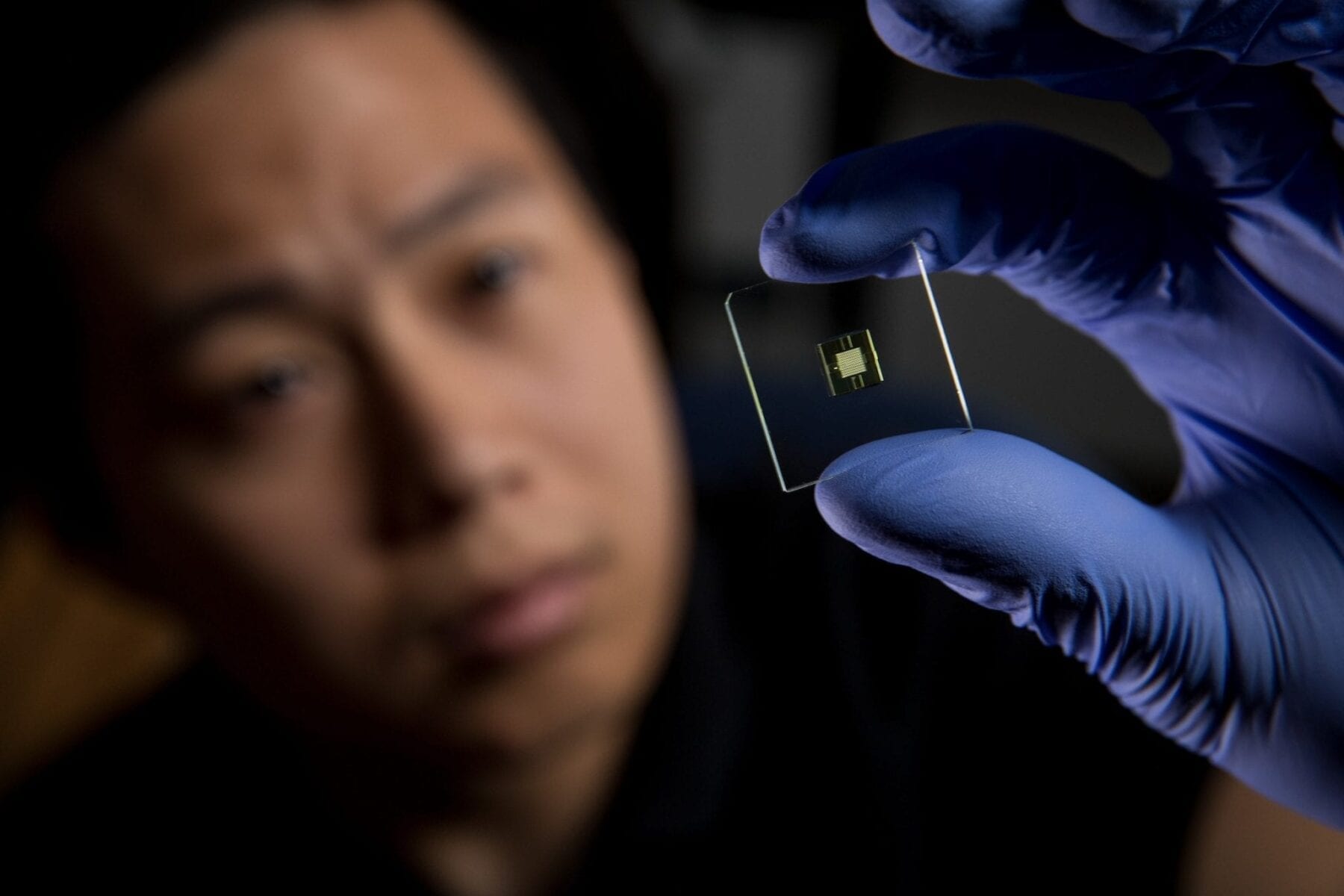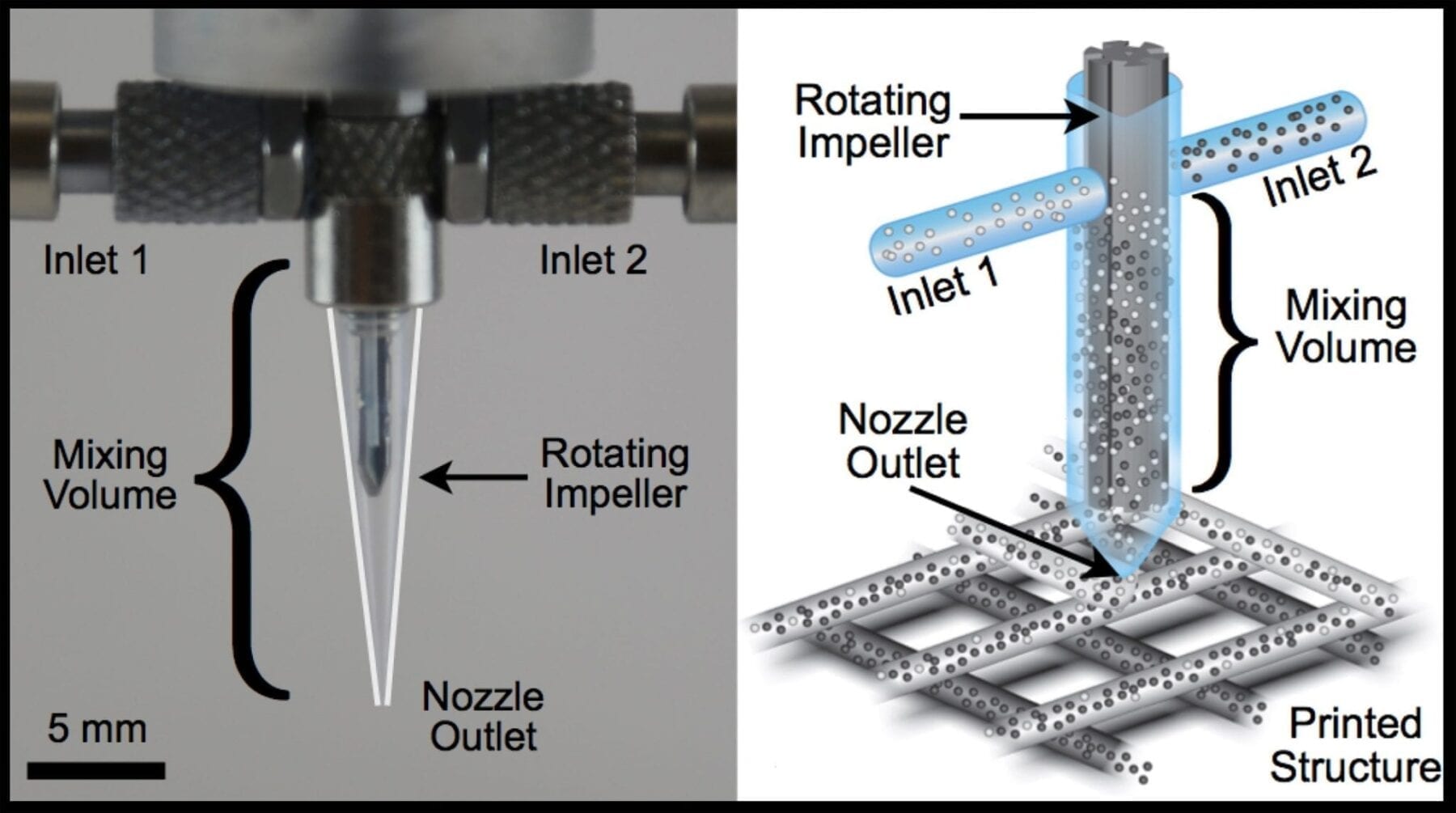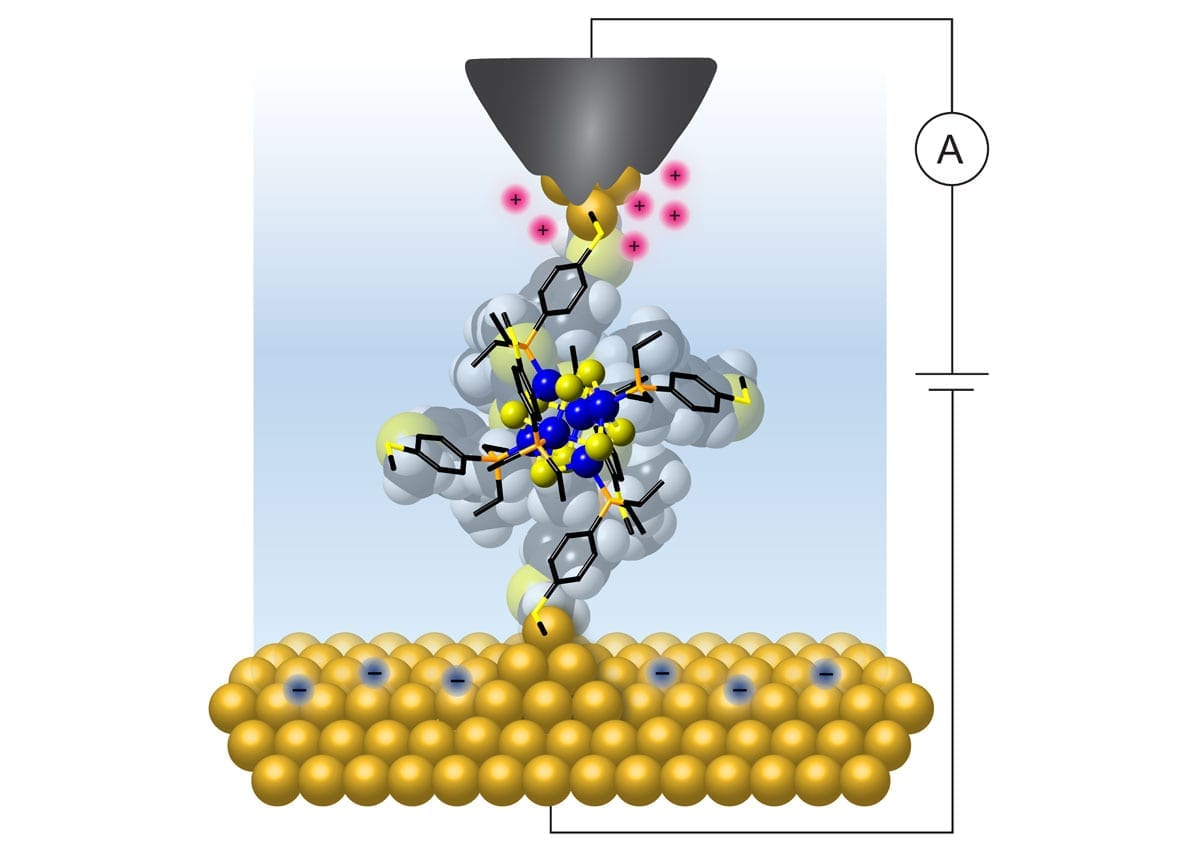
PhD student Hua Gong, who is also an author on the paper, looks at a 3D-printed microfluidic device
Previous researchers have used 3D printers to make microfluidics, but not on this scale
Researchers at BYU are the first to 3D-print a viable microfluidic device small enough to be effective at a scale much less than 100 micrometers. Microfluidic devices are tiny chips that can sort out disease biomarkers, cells and other small structures in samples like blood by using microscopic channels incorporated into the devices.
The accomplishment, which is a major breakthrough toward mass-producing the medical diagnostic devices cheaply, is detailed in the latest issue of the academic journal Lab on a Chip. Researchers Greg Nordin, a BYU electrical engineering professor, and Adam Woolley, a BYU chemistry professor, say the key to their innovation was two-fold:
- Building their own 3D printer to print at a much higher resolution
- Using a new, specifically designed, low-cost, custom resin
“Others have 3D-printed fluidic channels, but they haven’t been able to make them small enough for microfluidics,” Nordin said. “So we decided to make our own 3D printer and research a resin that could do it.”
Their work has produced labs on a chip with flow channel cross sections as small as 18 micrometers by 20 micrometers. Previous efforts to 3D-print microfluidic devices have failed to achieve success smaller than 100 micrometers. The researchers’ 3D printer uses a 385 nm LED, which dramatically increases the available selection of UV absorbers for resin formulation compared to 3D printers with 405 nm LEDs.
Nordin said the advantages of 3D printing for microfluidic device fabrication are already well-known and that their method, digital light processing stereolithography (DLP-SLA), is an especially promising lower-cost approach. DLP-SLA uses a micromirror array chip, like those in most consumer projectors, to dynamically create the optical pattern for each layer during layer-by-layer printing of a device.

Researchers say they are laying the foundation for 3D printing to challenge the dominance of conventional methods — soft lithography and hot embossing — of microfluidic prototyping and development.
“We’re deliberately trying to start a revolution in how microfluidic devices are fabricated,” Nordin said.
Woolley’s research interests in microfluidics focus on using lab-on-a-chip devices to detect biomarkers related to preterm birth. To that end, he and Nordin just submitted a proposal to the National Institutes of Health to develop the approach in this paper for preterm birth prediction.
Woolley said the paper represents an improvement of a factor of 100 on the size of features that are now possible in 3D printed microfluidics. It also cuts down on time and hassle: the BYU-authored approach can create a device in 30 minutes’ time and doesn’t require the use of clean rooms — a special lab environment free from dust and other contaminants.
“It’s not just a little step; it’s a huge leap from one size regime to a previously inaccessible size regime for 3D printing,” Woolley said. “It opens up a lot of doors for making microfluidics more easily and inexpensively.”
Learn more: Professors 3D-print first truly microfluidic “lab on a chip” device
The Latest on: 3D printed lab-on-a-chip
[google_news title=”” keyword=”3D printed lab-on-a-chip” num_posts=”10″ blurb_length=”0″ show_thumb=”left”]- A 3D Printer On Every Desk? Why Companies Are Buying More 3D Printerson May 2, 2024 at 4:56 am
Entry-level desktop 3D printers saw record sales in 2023. It’s not the number of machines sold that’s surprising; it’s who’s buying them: businesses.
- Grounded: How To Get The Haze Lab BURGL Chipon May 1, 2024 at 4:05 am
Obtaining the BURG.L chip from the Haze Lab in Grounded requires players to complete a few steps before claiming the prize. Your browser does not support the video ...
- Best 3D Printer for 2024on April 23, 2024 at 1:26 am
We've tested and reviewed several models to find the top 3D printers, including options from Prusa, Anycubic, Elegoo, Bambu Lab and more ... professionally in the 3D printing space / 4 years ...
- A 3D Printer Used By Microsoft, Ford, and NASA Is Now Commercially Available — Here's What It Can Doon April 17, 2024 at 8:41 am
A 3D printer already ... Times tested the Bambu Lab X1 Carbon ($1,200), the Bambu Lab P1P ($700), and the Prusa MK4 ($1,100) and found that they were all able to print faster than expected.
- 3D printers just got a big, eco-friendly upgrade (in the lab)on April 8, 2024 at 10:59 am
By Andrew Paul | Published Apr 8, 2024 2:00 PM EDT Researchers developed a 3D printer that can automatically identify the parameters of an unknown material on its own. The advance could help make ...
- This 3D printer can figure out how to print with an unknown materialon April 8, 2024 at 9:00 am
They started with a 3D printer their lab had previously developed that can capture data and provide feedback as it operates. The researchers added three instruments to the machine’s extruder ...
- This 3D printer can figure out how to print with an unknown materialon April 8, 2024 at 7:53 am
They started with a 3D printer their lab had previously developed that can capture data and provide feedback as it operates. The researchers added three instruments to the machine's extruder that take ...
- An Introduction to Lab-on-a-Chip Technology in Clinical Diagnostics: Successes and Remaining Challengeson March 26, 2024 at 12:00 am
Lab-on-a-chip platforms enable advanced processing, manipulation, and analysis of biological samples in miniaturized fluidic devices. Despite the numerous advantages, such as lower reagent and sample ...
- Lab on a Chip News and Researchon November 1, 2023 at 5:00 pm
Researchers described the development and applications of a 3D-printed lab-on-a-chip device that quickly detected the presence of SARS-CoV-2 in patient's saliva. A University of Texas at Arlington ...
- 3d printedon July 8, 2023 at 5:00 pm
It’s also a great way to put the 3D printer to work, along with this other piece of 3D-printed lab equipment designed for agitating cell cultures instead.
via Google News and Bing News










